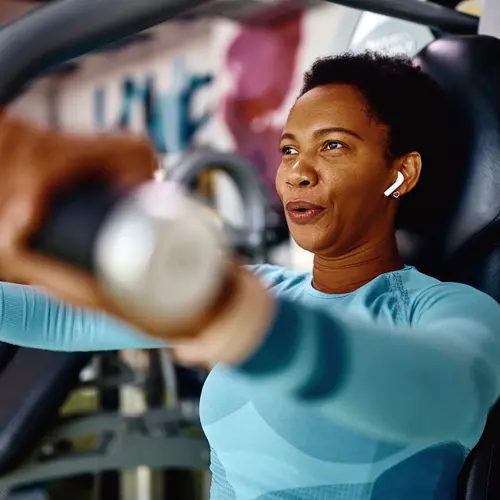If you have an overactive bladder, you may think it’s just a natural part of life or be too embarrassed to tell your doctor.
But that’s a mistake. It’s a common problem, and there are lots of things that can help, including certain exercises, medication, and Botox. Here’s what you need to know.
Lifestyle Changes
If you don’t want to take drugs, try these tips:
Lose weight. Experts think extra pounds put more pressure on your bladder, increasing the urge to pee. In one study, overweight and obese women reported fewer overactive bladder episodes after losing weight.
Watch what you drink. Keep track of how much and when in a fluid diary. Then cut back by 25%. But don’t drink less than 34 ounces (1 liter) a day. If you don’t sip enough, your pee can turn very dark and become concentrated. That can irritate your bladder and make you feel like you need to go. Try to drink small amounts of fluid throughout the day instead of large amounts all at once. Limit coffee, alcohol, and sodas, which can worsen symptoms. If you get up a lot at night to pee, stop drinking about 3 hours before bedtime.
Fuel up on fiber. Constipation can put extra pressure on your bladder, too. Try to eat 30 grams of fiber a day. Options include almonds, oats, pears, raspberries, lentils, and beans.
Time your toilet trips. Try to pee on a regular schedule, not just when you feel the urge. That might mean every 2 to 4 hours. You’ll have to figure out what works for you.
Do your Kegels. Also known as pelvic muscle exercises, these strengthen the muscles around your bladder. Here’s how to do them:
- If you have a vagina, put one finger in and squeeze around it. If you have a penis, tighten the muscles you use to stop yourself from peeing. These are the same ones you’ll use to do Kegels.
- Squeeze them for about 8 to 10 seconds, then relax. At first, it may be hard to hold for more than a second or two. Try to do eight to 12 contractions three times a day. Over time, try to squeeze harder and longer.
- Do Kegels during any activity that can cause urine leakage, like exercise, coughing, or sneezing.
Train your bladder. Some people can “train” their bladder to hold more urine. Start with going every 30 minutes or every hour. If you have the urge to pee before the scheduled time, try to distract yourself. Take deep breaths or practice Kegels. Once you can do that, increase the time between bathroom breaks by 15 minutes. Try to keep this up until you can go 3 or 4 hours without using the restroom. This may take several weeks.
Try physical therapy. If you don’t think you’re doing Kegels the right way, a physical therapist can show you how. They might use biofeedback. This is when sensors are placed on either side of your butt and across your stomach. They’re connected to a computer screen, which will show you when you’re using the right muscles.
Medications
Your doctor may recommend medication if lifestyle changes don’t work or you have a severe case of overactive bladder. These include:
Vaginal estrogen therapy. If you’ve already gone through menopause, this can strengthen your bladder muscles. It comes in a tablet, cream, or a ring or suppository that you put in your vagina.
Anticholinergics. These drugs stop bladder muscle contractions. Two are available over the counter: the tolterodine (Detrol) and the Oxytrol patch. Prescription options include:
- Darifenacin (Enablex)
- Fesoterodine (Toviaz)
- Oxybutynin (Ditropan, Gelnique)
- Solifenacin (Vesicare)
- Trospium (Sanctura)
Side effects include:
- Dry eyes and mouth
- Constipation
Anticholinergics have also been linked to dementia.
Mirabegron (Myrbetriq). This drug relaxes your bladder muscles so it’s easier to hold urine. But it can raise blood pressure, so you’ll need to be monitored closely by your doctor. Research shows it works better when you take it with an anticholinergic.
The FDA recently approved vibegron (Gemtasa) for treatment of OAB. It works the same way Myrbetriq does.
Other Treatments
Percutaneous tibial nerve stimulation. This sends electrical pulses to the nerves in the lower back that affect your bladder. You’ll need treatment once a week for 12 weeks, then once a month. Studies show it’s very effective. But a lot of people stop treatment because it can be difficult to keep all the appointments. You can’t do this therapy if you have a pacemaker.
Botox. It does more than get rid of wrinkles. Botox can be life-changing for people with OAB who haven’t responded to other treatments. Your bladder is numbed with lidocaine, then injected with Botox. The whole procedure takes about 30 minutes. A small amount of people -- about 6% -- find that it's hard to fully empty their bladder after Botox treatment. If that happens to you, you will have to be taught to insert a catheter to get rid of urine. Usually, that only lasts for a few weeks. You’ll need follow-up injections about every 6 months.
Sacral neuromodulation. This is when a surgeon puts a small device called a sacral nerve stimulator (SNS) under the skin of your upper butt. They’ll connect it to the sacral nerve in your lower back. This sends electrical impulses to your bladder to help symptoms of OAB. You can try it temporarily or get a permanent implant. Risks include pain at the surgical site and infection.

